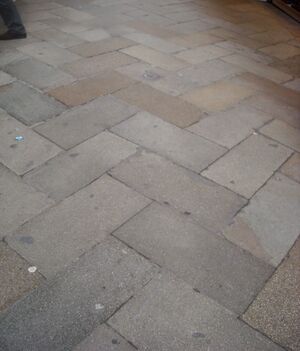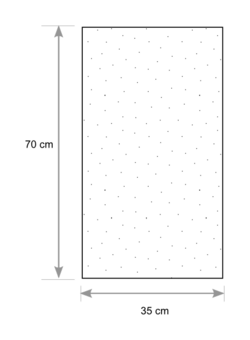Salizzone: Difference between revisions
No edit summary |
No edit summary |
||
| Line 1: | Line 1: | ||
[[File:paving.jpg|right|thumb|These are all ''salizzone'' arranged in the [[Herring Bone]] pavement style]] | [[File:paving.jpg|right|thumb|These are all ''salizzone'' arranged in the [[Herring Bone]] pavement style]] | ||
[[File:Salizzone--diagram.png|left|thumb|250 px|Salizzone diagram]] | [[File:Salizzone--diagram.png|left|thumb|250 px|Salizzone diagram]] | ||
''Salizzone'' is a Venetian term, when translated to English literally means paved street. In reality, ''salizzone'' are pavement stones made from [http://en.wikipedia.org/wiki/Trachyte trachyte], a volcanic stone quarried in the Colli Euganei, this is the same material used to make ''[[Masegno]]''.<ref>Ing. Lorenzo Bottazo,November 3rd 2011</ref> ''Salizzone'' and ''[[Masegno]]'' are very similar, the only differences being the size of the stones and the fact that all ''salizzone'' are new stones while most ''[[Masegno]]'' date back to the 18th and 19th century. ''Salizzone'' have a larger surface area than ''[[Masegno]]'' and are made to be only 2 specific sizes; the majority of ''salizzone'' are 35cm by 70cm, while a less common size is 28cm by 56cm.<ref>Ing. Lorenzo Bottazo, November 3rd 2011</ref> Due to the fact that ''salizzone'' stones are all uniform in size they are always used for the [[Herring | ''Salizzone'' is a Venetian term, when translated to English literally means paved street. In reality, ''salizzone'' are pavement stones made from [http://en.wikipedia.org/wiki/Trachyte trachyte], a volcanic stone quarried in the Colli Euganei, this is the same material used to make ''[[Masegno]]''.<ref>Ing. Lorenzo Bottazo,November 3rd 2011</ref> ''Salizzone'' and ''[[Masegno]]'' are very similar, the only differences being the size of the stones and the fact that all ''salizzone'' are new stones while most ''[[Masegno]]'' date back to the 18th and 19th century. ''Salizzone'' have a larger surface area than ''[[Masegno]]'' and are made to be only 2 specific sizes; the majority of ''salizzone'' are 35cm by 70cm, while a less common size is 28cm by 56cm.<ref>Ing. Lorenzo Bottazo, November 3rd 2011</ref> Due to the fact that ''salizzone'' stones are all uniform in size they are always used for the [[Herring Bone]] pavement layout.<ref>Ing. Lorenzo Bottazo,November 3rd 2011</ref> ''Salizzone'' are made with slanted edges on the bottom, which allows faster and easier removal during [[Street Maintenance]]. | ||
Latest revision as of 18:30, 6 December 2012


Salizzone is a Venetian term, when translated to English literally means paved street. In reality, salizzone are pavement stones made from trachyte, a volcanic stone quarried in the Colli Euganei, this is the same material used to make Masegno.[1] Salizzone and Masegno are very similar, the only differences being the size of the stones and the fact that all salizzone are new stones while most Masegno date back to the 18th and 19th century. Salizzone have a larger surface area than Masegno and are made to be only 2 specific sizes; the majority of salizzone are 35cm by 70cm, while a less common size is 28cm by 56cm.[2] Due to the fact that salizzone stones are all uniform in size they are always used for the Herring Bone pavement layout.[3] Salizzone are made with slanted edges on the bottom, which allows faster and easier removal during Street Maintenance.
See Also
References
Bibliography
NULL
External Links
NULL